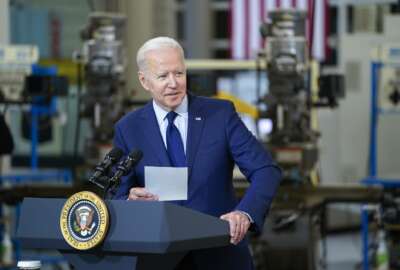
Ahuja plans to fix OPM programs under the microscope of the House Oversight Committee
Among heated questions about federal telework, the House Oversight and Accountability Committee urged Office of Personnel Management Director to make improvements...
The House Oversight and Accountability Committee zeroed in on examining several federal programs with long-standing challenges, housed under the Office of Personnel Management.
Among heated questions about federal telework, committee members pressed OPM Director Kiran Ahuja on how she plans to improve challenges in other departments at the agency, including in retirement services and the Federal Employees Health Benefits (FEHB) Program, as well as the federal hiring process.
Retirement services backlog
Challenges in retirement services at OPM were a common concern among both Democrats and Republicans on the committee — and even for Ahuja herself — during a March 9 hearing on OPM’s operations.
OPM’s largely paper-based retirement services system has faced years of delays and backlogs, which increased during the COVID-19 pandemic due to a surge of retirement requests.
“Even with the surge in retirement, we have increased production of cases by 20%,” Ahuja said during the hearing. “We’ve brought down the inventory there, and we are doing work towards addressing some of the customer services service challenges with our call center, in particular trying to move more of the common questions online.”
Still, some committee members didn’t see a 20% reduction as much of a success, and largely blamed the retirement case backlog on delays caused by teleworking employees.
“20% … isn’t anything if you’re improving from such a low bar,” Rep. Virginia Foxx (R-N.C.) said. “We don’t want to hear about improving percentages when the bar was set so low. Just tell people to come back to work and answer the needs of the constituents. They need to be in their offices.”
Other challenges, including a high turnover of OPM directors and the proposed merger with the General Services Administration, have led to difficulties for the agency to address legacy IT in retirement services. Ahuja is the longest serving permanent OPM director since at least 2015.
“The period of time that we lost when there were efforts to dissolve the agency certainly had a huge impact on retirement services,” Ahuja said.
Similar to prior OPM leaders, Ahuja vowed during her Senate confirmation hearing to address the longstanding issues with retirement services.
The agency is already taking further steps, Ahuja said, to address the outdated system, and will launch a modernization pilot later this year. The update will include an online retirement application, an annuity calculator and other self-service tools to try to reduce the backlog of retirement requests.
OPM is also launching a chatbot to help prospective retirees get answers to their questions more quickly. And the agency has created a cloud-based call center for retirement services, to try to ensure employees’ and retirees’ calls to the customer service line aren’t dropped.
Some of these IT modernization efforts are broader at OPM as well. Guy Cavallo, the agency’s chief information officer (CIO) has said that his team is in the process of launching an updated OPM website, something that is already publicly visible for some sections of OPM’s web domain.
But many of these modernization efforts will require significant funding, according to Ahuja.
“We have not had the investments around staffing,” she said during the hearing. “Doing the modernization efforts that we’re now doing, that’s going to take time.”
These modernization efforts come after OPM received additional funding in the fiscal 2023 omnibus spending package to address the agency’s legacy IT. According to Cavallo, OPM’s retirement services houses the majority of legacy IT at the agency.
Rep. Shontel Brown (D-Ohio) called the long waiting periods for OPM to process retirement claims “unacceptable,” and raised concerns about the system as a whole.
“OPM’s retirement service has its challenges — a high processing backlog, complaints about its customer services and call center, and improper payments,” Brown said. “The system also relies on paper-based manual processing, has insufficient staffing and old IT.”
The time to process retirement claims has recently decreased, despite an influx of claims during the winter months. The time to process claims has declined by 30 days since 2021, from 95 days, now down to 65 days. But OPM still has 23,500 claims sitting in its inventory, well above its steady state goal of 13,000.
The fiscal 2024 budget request from the White House asks for $15.8 million for IT modernization at OPM — and a large part of that would focus specifically on modernizing the agency’s retirement services department.
OPM’s retirement services department as a whole received about $76.3 million in the enacted 2023 budget. For 2024, the Biden administration is requesting roughly $87.6 million for the department — an increase of more than $11 million. Overall, OPM’s budget request for 2024 is $464 million, more than $78 million above the enacted 2023 level.
Improper payments in FEHB
The Federal Employees Health Benefits (FEHB) Program also came under scrutiny during the committee hearing. Several members pointed to a report from the Government Accountability Office showing that OPM spends about $1 billion annually on ineligible FEHB members.
Without a monitoring mechanism to identify and remove ineligible members from FEHB, GAO said these costs will keep accruing.
“GAO’s report suggests OPM has been aware of this problem for years but has consistently failed to address it effectively. As GAO recounts, OPM acknowledged the possibility of a problem when it issued regulations in 2018 allowing agencies and participating insurers to request proof of eligibility for federal employees’ family members. OPM did not, however, actually require proof of eligibility,” Chairman James Comer (R-Ky.) said in a Jan. 23 letter to Ahuja.
In response to the concerns, Ahuja said during the hearing that OPM is working on creating a master enrollment index (MEI) — essentially a roster of FEHB subscribers and family members. The creation of an MEI has been in the works in OPM’s FEHB department for at least the last couple of years.
“We have been focused on this issue,” Ahuja said. “It’s a very decentralized health benefits program. We’ve been working with agencies and carriers to be able to ensure that we manage any ineligibility.”
Ahuja said the index will help clear up discrepancies in FEHB enrollment between both agencies and health carriers.
“That’s going to be a way forward,” she said.
But there are ongoing challenges within the FEHB department at OPM. Top of the list, Ahuja said, is underfunding.
“Certainly the prior years were challenging … so we are certainly navigating those issues as well, and figuring out a solution,” she said.
Notably, OPM’s fiscal 2024 budget request includes about $62 million for healthcare and insurance — that’s nearly double the 2023 enacted level of $34.2 million for that area of OPM.
Federal hiring reform
Committee members also pressed Ahuja on her plans for federal hiring reform — an issue that has remained top of mind for OPM and other agencies for years.
Ahuja said OPM is placing additional emphasis on recruitment and retention of cybersecurity and IT professionals, an area that remains on OPM’s list of governmentwide skills gaps.
OPM has a cyber talent management plan, Ahuja said, that the agency plans to share with Congress members “very soon,” to try to better recruit employees for this sector of the federal workforce.
“That is going to focus on hiring flexibilities and other efforts across government, similar to what we’ve done with [the Defense Department] and [the Department of Homeland Security],” Ahuja said. “It is about increasing pay [and] other flexibilities.”
OPM has also approved a special salary rate for federal IT and cybersecurity positions, in an effort to address the longstanding skills gaps in these fields.
“If we have 2,500 jobs over a few years that never get filled, that’s a challenge that we should care about,” Ahuja said.
Regardless of the type of federal position, some committee members questioned whether the Biden administration’s focus on improving diversity, equity, inclusion and accessibility (DEIA) would hinder agencies’ abilities to hire the best-suited candidates for open roles.
“Your agency’s budget justification for [fiscal 2023] even lists fostering a diverse, equitable, inclusive and accessible workplace as its second highest strategic priority above other directives such as building the skills of the federal workforce and attracting skilled talent,” Rep. Jake LaTurner (R-Kan.) said during the hearing.
OPM, though, has said that DEIA should be an integral part of building the federal workforce and recruiting high-quality candidates. The fiscal 2024 budget justification for OPM builds on a similar emphasis of DEIA from this year’s budget.
Ahuja said OPM is focused strongly on skills-based hiring, and noted that DEIA encompasses other underserved groups beyond racial diversity. The Biden administration’s DEIA executive order also includes efforts to support, for instance, veterans and military spouses.
“Like the private sector, we are placing a strong emphasis on attracting a diverse workforce to the federal government,” Ahuja said. “Diversity of thought and experience, geography and background — the American public benefits when the federal government fully embraces the principles of diversity, equity, inclusion and accessibility.”
Copyright © 2024 Federal News Network. All rights reserved. This website is not intended for users located within the European Economic Area.
Drew Friedman is a workforce, pay and benefits reporter for Federal News Network.
Follow @dfriedmanWFED
Related Stories





